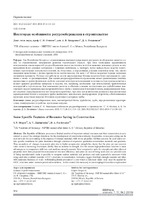| dc.contributor.author | Осипов, С. Н. | ru |
| dc.contributor.author | Захаренко, А. В. | ru |
| dc.contributor.author | Поздняков, Д. А. | ru |
| dc.coverage.spatial | Минск | ru |
| dc.date.accessioned | 2018-04-11T06:12:12Z | |
| dc.date.available | 2018-04-11T06:12:12Z | |
| dc.date.issued | 2018 | |
| dc.identifier.citation | Осипов, С. Н. Некоторые особенности ресурсосбережения в строительстве = Some Specific Features of Resource Saving in Construction / С. Н. Осипов, А. В. Захаренко, Д. А. Поздняков // Наука и техника. – 2018. – № 2. - С. 114-122. | ru |
| dc.identifier.uri | https://rep.bntu.by/handle/data/40191 | |
| dc.description.abstract | Для Республики Беларусь с ограниченными важными природными ресурсами их сбережение является одним из стратегических направлений развития строительной отрасли. При этом наибольшая эффективность использования закономерностей ресурсосбережения может достигаться не путем экономии денежных средств за счет применения более дешевых материалов с худшими свойствами, а, наоборот, путем выбора более дорогих качественных строительных материалов и изделий, но, безусловно, в определённых условиях изменения цены. Так, анализ изменения цены бетона с ростом прочности на сжатие показал, что цена 1 м³ бетона возрастает гораздо медленнее увеличения прочности. Поэтому для работы на сжатие высокопрочные бетоны являются более выгодными по сравнению с низко- и среднепрочными. Для оценки ресурсоэффективности предложены новые сравнительные единицы прочностных и других физических свойств: удельные цена (при использовании) и стоимость (при производстве) позволяют сравнить различные материалы и изделия, что, например, необходимо при использовании трубобетонных конструкций в строительстве. Как показывают расчеты, в обычных условиях эксплуатации для трубобетонных конструкций следует применять высокопрочный бетон и трубы с минимальной толщиной стенок, выдерживающих боковое давление деформирующегося под нагрузкой сердечника. При этом для компенсации различия в деформационных характеристиках бетона и материала трубы необходимо использовать демпфирующие устройства, обеспечивающие предельно допустимые нагрузки бетонного сердечника и материала трубы. | ru |
| dc.language.iso | ru | ru |
| dc.publisher | БНТУ | ru |
| dc.subject | Ресурсосбережение | ru |
| dc.subject | Высокопрочный бетон | ru |
| dc.subject | Трубобетон | ru |
| dc.subject | Труба | ru |
| dc.subject | Деформационные характеристики | ru |
| dc.subject | Демпфирующее устройство | ru |
| dc.subject | Предельные нагрузки | ru |
| dc.subject | Resource saving | en |
| dc.subject | High-performance concrete | en |
| dc.subject | Tube concrete | en |
| dc.subject | Tube | en |
| dc.subject | Deformation characteristics | en |
| dc.subject | Damping device | en |
| dc.subject | Maximum safe load | en |
| dc.title | Некоторые особенности ресурсосбережения в строительстве | ru |
| dc.title.alternative | Some Specific Features of Resource Saving in Construction | en |
| dc.type | Article | ru |
| dc.identifier.doi | 10.21122/2227-1031-2018-17-2-114-122 | |
| local.description.annotation | The Republic of Belarus possesses a limited number of important natural resources and their conservation is considered as one of the strategic directions for the development of construction industry. Regularities in resource saving can be used not only for cost-cutting at the expense of cheaper materials with worse properties but they can also be used under certain specific conditions for price formation through selection of expensive qualitative construction materials and products. Thus an analysis of changes in concrete price due to higher compressive strength has shown that the price per one concrete cubic metre is increasing much more slowly than an increase in strength. For this reason high-performance concrete is more advantageous in comparison with low- and medium-strength concrete. New comparative units for strength and other physical properties have been proposed for assessment of resource efficiency: unit price (in case of being used) and cost price (in case of being manufactured) make it possible to compare various materials and products and such approach is necessary while using steel tube confined concrete (STCC) structures in construction. Estimates suggest that high-strength concrete and tubes with minimum thickness of walls withstanding lateral pressure of a core which is deformed under load must be applied for STCC structures under normal operational conditions. In this context it is necessary to use damping devices for compensation of difference in characteristics of concrete and tube material and these devices ensure maximum safe load of concrete core and tube material. | en |

